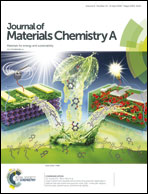Reactive stability of promising scalable doped ceria materials for thermochemical two-step CO2 dissociation†
Abstract
Metal-doped ceria (Ce1−xMxO2−δ) is an attractive redox-active material for thermo/electrochemical synthesis of renewable fuels due to its high mixed ionic/electronic conductivity and variable valence (Ce4+/Ce3+) and oxygen nonstoichiometry (δ) at high temperatures. Previously, we have investigated all 26 potentially tetravalent dopants for efficient thermochemical splitting of CO2. Here, we fine-tune the dopant activity (x = 0.10 Zr4+, 0.10 Hf4+, 0.07 Ta5+, and 0.05 Nb5+) of all thermally stable ceria materials with an oxygen exchange capacity (OEC) surpassing that of pristine ceria (CeO2−δ), and we employ thermogravimetric analysis to evaluate long-term stability of their OEC over 50 consecutive redox cycles. Each cycle swings between 40 min ceria oxidation with approximately 500 mbar CO2 at 1000 °C and 90 min ceria reduction in about 0.01 mbar O2 at 1500 °C. Along with analyses of phase purity and stability (PXRD), of composition and dopant concentration (EDX and ICP-MS), and of sintering via SEM, the cycling results show long-term stable OEC and kinetics of the oxygen exchange for Zr-, Hf-, and Nb-doped ceria, despite their distinctly sintered particle surfaces. This attractive performance is rationalized by characterizing oxidation states and oxygen vacancies and by excluding surface carbonation through Raman and FT-IR spectroscopy. Furthermore, we find that introducing stable oxygen vacancies in Ce0.95Hf0.05O2−δ by doping with additional 5% lower-valent Li+, Mg2+, Ca2+, Y3+, and Er3+ does not significantly accelerate the oxygen exchange kinetics. From this first comprehensive long-term stability study of systematically optimized ceria, we propose ceria co-doped with permutations of Hf4+, Zr4+, and Nb5+, yielding an optimal average dopant radius of 0.8 Å, as the benchmark redox material for thermochemical production of solar fuels.



 Please wait while we load your content...
Please wait while we load your content...